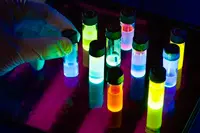 Organic LEDs are attractive not only because they emit light in all observation directions, but also for their colours and high contrast. It is also possible to manufacture transparent and flexible OLEDs, enabling new applications.
Organic LEDs are attractive not only because they emit light in all observation directions, but also for their colours and high contrast. It is also possible to manufacture transparent and flexible OLEDs, enabling new applications.
OLEDs consist of ultra thin layers of organic materials – the emitter – between two electrodes. When a voltage is applied, electrons from the cathode and holes from the anode are injected into the emitter, where they form electron-hole pairs, or excitons, which release energy when they decay.
Excitons have two states: singlet excitons decay immediately and emit light, whereas triplet excitons release their energy in the form of heat. To enhance the energy efficiency of an OLED, triplet excitons are used to generate light. Conventional LEDs use heavy metals, such as iridium and platinum, for this purpose, but these materials are expensive, have a limited availability and require complex production methods.
According to the team, it is cheaper and more environmentally friendly to use copper complexes as emitter materials. A process known as thermally activated delayed fluorescence (TADF) ensures high light yields and, hence, high efficiency.
TADF is based on the quantum mechanics phenomenon of intersystem crossing (ISC) and, for the first time, the speed of ISC has been measured in a highly luminescent solid state TADF copper(I) complex. The researchers – from Karlsruhe Institute of Technology, OLED manufacturer Cynora and the University of St Andrews – the transition from singlet to triplet took 27ps, whilst the reverse process saw a TADF of 11.5µs.
The researchers say these measurements should help to improve the understanding of mechanisms which lead to TADF, as well as contributing to the specific development of TADF materials for use in energy efficient OLEDs.
Author
Graham Pitcher
Source: www.newelectronics.co.uk

